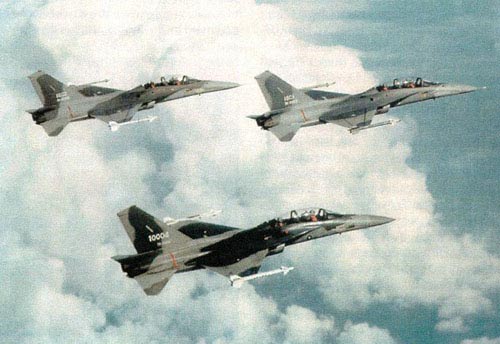F-CK-1 Ching-Kuo
Summary
| Category | Combat Aircraft |
| Origin country | 🇹🇼 Taiwan |
| Manufacturer | AIDC |
| First flight | 28 May 1989 |
| Year introduced | 1994 |
| Number produced | 137 units |
| Average unit price | $30 million |
Description
The FCK-1 Ching Kuo is a multirole fighter aircraft developed by the Aerospace Industrial Development Corporation (AIDC) in Taiwan. The project commenced in the late 1980s with the aim to reduce Taiwan's dependency on foreign military technology, particularly from the United States. The development was prompted, in part, due to the U.S. refusing to sell advanced fighter jets like the F-16 to Taiwan at that time, largely because of political considerations involving the People's Republic of China.
The aircraft took its maiden flight in 1989 and became operational in the mid-1990s. It was designed to be comparable to fighters of its era, with features such as a radar system, beyond-visual-range (BVR) capabilities, and modern avionics. Over the years, the FCK-1 has undergone several upgrades to improve its combat capabilities.
The development and design of the FCK-1 Ching Kuo were complex endeavors that involved a blend of domestic and foreign expertise. Constrained by the unavailability of cutting-edge foreign fighter jets due to political factors, Taiwan's Aerospace Industrial Development Corporation (AIDC) took the lead in creating a home-grown solution. Technical collaboration was sought from American companies for some of the aircraft's key systems. For instance, the aircraft's avionics and radar capabilities were developed with assistance from U.S.-based contractors. However, much of the work, including aerodynamic design and systems integration, was conducted in Taiwan.
The aircraft was designed as a multirole fighter, capable of air-to-air and air-to-ground missions. It features a single-engine, twin-tail configuration, optimized for agility and speed. The FCK-1 was equipped with modern radar for beyond-visual-range engagement, which was a significant leap forward for Taiwan's indigenous defense capabilities at the time of its introduction. The cockpit was designed to be ergonomic, with a focus on reducing pilot workload through the use of advanced avionic systems, including a heads-up display and multi-function displays.
The development wasn't without challenges but the FCK-1 Ching Kuo was a significant step in building Taiwan's indigenous aerospace capabilities, allowing the country to possess a modern, multirole fighter that could be adapted and upgraded over time to meet evolving defense requirements.
Armament
The FCK-1 Ching Kuo has a diverse set of weapon capabilities designed for both air-to-air and air-to-ground combat missions. The aircraft is equipped with an internal 20mm M61A1 Vulcan cannon, a six-barrel rotary gun, which is effective for close-in dogfighting. For air-to-air engagements, the FCK-1 can be armed with a variety of missiles, including the AIM-9 Sidewinder for short-range combat and the domestically produced Tien Chien II (Sky Sword II) for medium-range engagements. The aircraft's beyond-visual-range capabilities were significantly enhanced with the incorporation of these missile systems.
For air-to-ground missions, the FCK-1 can carry a range of munitions including laser-guided bombs, cluster bombs, and unguided rockets. It has multiple hardpoints under its wings and fuselage to allow a flexible weapons payload, enabling it to engage various types of ground targets effectively.
Operational history
The FCK-1 Ching Kuo became operational in the mid-1990s after a series of test flights and evaluations that commenced with its maiden flight in 1989. It was introduced into the Republic of China Air Force (ROCAF), Taiwan's air force, to serve alongside and eventually replace older aircraft in the inventory, such as the F-5E/F Tiger II. Since its introduction, it has become one of the primary fighter aircraft in Taiwan's air defense fleet.
While the FCK-1 has not seen combat, it has been involved in numerous training exercises and air defense missions. It plays a critical role in Taiwan's Quick Reaction Alert (QRA) system, designed to respond rapidly to airspace incursions. Given the geopolitical tensions in the Taiwan Strait, the aircraft is frequently scrambled to intercept Chinese planes that approach Taiwan's Air Defense Identification Zone (ADIZ).
The FCK-1 has participated in various military drills and joint exercises aimed at testing its capabilities and improving pilot proficiency. These exercises often simulate realistic combat scenarios, including air-to-air combat and ground attack missions, to evaluate the aircraft's performance and the effectiveness of its systems under operational conditions.
The FCK-1 hasn't been exported to other countries, primarily due to political pressures and export restrictions. Taiwan itself has supplemented its fleet with other foreign aircraft like the F-16, but the FCK-1 remains a symbol of the island's indigenous defense capabilities.
Variants
- FCK-1A: Single-seat version, designed primarily for air-to-air combat but with multirole capabilities. This was the initial production model.
- FCK-1B: Two-seat version, generally used for training missions but retains full combat capabilities. It provides an extra seat for an instructor or weapons systems officer.
- FCK-1C/D Hsiang Sheng: Upgraded single-seat (C) and two-seats (D) versions featuring improvements in avionics, radar systems, and weapon compatibility. Aimed at extending the aircraft's service life and enhancing its combat capabilities.
Technical specifications
| Version: F-CK-1A Ching-Kuo | |
|---|---|
| Crew | 1 pilot |
| Maximum speed | 2223 km/h (1381 mph) |
| Wing area | 24.2 m² (260.5 sqft) |
| Wingspan | 9 m (29.5 ft) |
| Height | 4.4 m (14.5 ft) |
| Length | 14.2 m (46.6 ft) |
| Service ceiling | 16,764 m (55,000 ft) |
| Empty weight | 6,486 kg (14,299 lbs) |
| Max. takeoff weight | 12,247 kg (27,000 lbs) |
| Powerplant | 2 x turbojets Honeywell F125-70 delivering 2722 kgf each |
| Ejection seat | Martin-Baker Mk 12 |
Current operating countries
| Country | Units | ||
|---|---|---|---|

|
Taiwan | 129 | |
All operators
Armament
